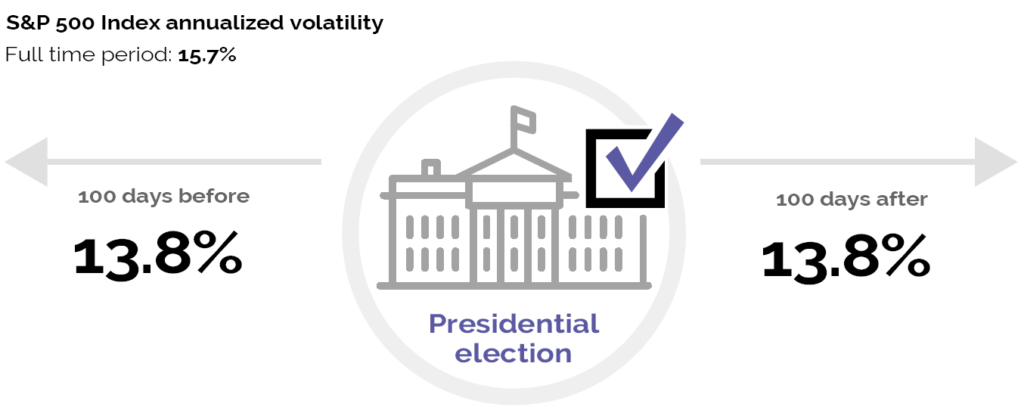Reading Time: 4 minutes
Election years often stir up market volatility, especially when candidates present starkly different viewpoints. While historical data can provide some insights, the future remains unpredictable. Election processes have evolved, with mail-in voting and concerns about voting fraud becoming more prominent issues. In fact, there is a thing called Election Stress Disorder, and perhaps you’ve experienced it.
Election Stress Disorder (ESD) refers to the heightened anxiety and stress individuals experience during election seasons. This phenomenon can be triggered by constant exposure to political news, social media debates, and the uncertainty surrounding election outcomes. Symptoms may include irritability, difficulty sleeping, and feelings of helplessness. Managing ESD involves limiting news consumption, and maintaining perspective on the election’s impact on daily life.
It’s crucial to remember that elections, despite generating headlines, should not deter you from adhering to your financial plan. While it’s natural to have concerns about the election’s impact, history suggests it will likely be a nonissue for your portfolio.
Elections Matter (But Not So Much to Your Investments)
Contrary to what the news might suggest, a wealth of empirical research indicates a different narrative. Vanguard conducted a comprehensive study on stock market performance during presidential election years. One key finding was that market returns do not vary drastically between election and non-election years. Examining data from 1860 to 2010, the average return difference is a mere 0.8%. In addition, Dimensional Fund Advisors has an interactive blog on “How Much Impact Does the President Have On Stocks.”

Markets Tend to Ignore Election Years
Another common concern is market volatility leading up to an election. Headlines and public sentiment might suggest increased market instability as elections approach. However, data shows otherwise. Analysis of the S&P 500’s volatility 100 days before and after elections reveals that volatility remained consistent at 13.8% in both periods. This demonstrates that markets generally tend to ignore the noise surrounding elections.

Staying the Course with Intelligent Investing

At Intelligent Investing, our mission is to minimize financial stress and maximize your life. We act as a buffer between sensational headlines and your portfolio. It’s natural to feel uneasy during election seasons, but it’s crucial to stay grounded and focus on your long-term financial plan.
Successful investing involves focusing on what you can control and keeping emotions secondary to your financial strategy. By maintaining perspective, discipline, and a long-term outlook, you can continue progressing toward your financial goals, despite the short-term uncertainties elections may bring.
The stock market often acts as a leading indicator, beginning to rise before an economic recovery is fully evident. This is one reason why markets can show upward movement even amid negative headlines. Pundits, economists, and other financial advisors will inevitably speculate on election outcomes and other significant events, but our investment philosophy is not based on short-term predictions. We believe in long-term investing, diversification across asset classes, and adherence to risk management principles.
As Leo Tolstoy wisely said, “The two most powerful warriors are patience and time.” Regardless of the election outcome, we appreciate our clients’ trust in us as their financial accountability partner. Our mission is to guide our clients away from emotional extremes, coaching them on adhering to their financial plan, and helping them stay aligned with their long-term goals and risk tolerance.
Consider joining our clients and making Intelligent Investing your financial accountability partner. Together, we can navigate the uncertainties of election seasons and beyond, ensuring that your investments remain aligned with your long-term objectives.
Schedule a short discovery call or meetingDisclosures:
Returns Graphic: Vanguard calculations, based on data from Global Financial Data as of December 31, 2019. Data represents the 60% GFD US-100 Index and 40% GFD US Bond Index, as calculated by historical data provider Global Financial Data. The GFD US-100 Index includes the top 25 companies from 1825 to 1850, the top 50 companies from 1850 to 1900, and the top 100 companies by capitalization from 1900 to the present. In January of each year, the largest companies in the United States are ranked by capitalization, and the largest companies are chosen to be part of the index for that year. The next year, a new list is created and it is chain-linked to the previous year’s index. The index is capitalization-weighted, and both price and return indices are calculated. The GFD US Bond Index uses the U.S. government bond closest to a 10-year maturity without exceeding 10 years from 1786 until 1941 and the Federal Reserve’s 10-year constant maturity yield beginning in 1941. Each month, changes in the price of the underlying bond are calculated to determine any capital gain or loss. The index assumes a laddered portfolio that pays interest on a monthly basis.
Volatility Graphic: Vanguard calculations of S&P 500 Index daily return volatility from January 1, 1964, through December 31, 2019, based on data from Thomson Reuters. Note: Past performance is no guarantee of future returns. The performance of an index is not an exact representation of any particular investment, as you cannot invest directly in an index.
Notes:
Past performance is no guarantee of future returns. The performance of an index is not an exact representation of any particular investment, as you cannot invest directly in an index. All investing is subject to risk, including possible loss of principal. Be aware that fluctuations in the financial markets and other factors may cause declines in the value of your account. There is no guarantee that any particular asset allocation or mix of funds will meet your investment objectives or provide you with a given level of income. Diversification does not ensure a profit or protect against a loss. Investments in bonds are subject to interest rate, credit, and inflation risk.




